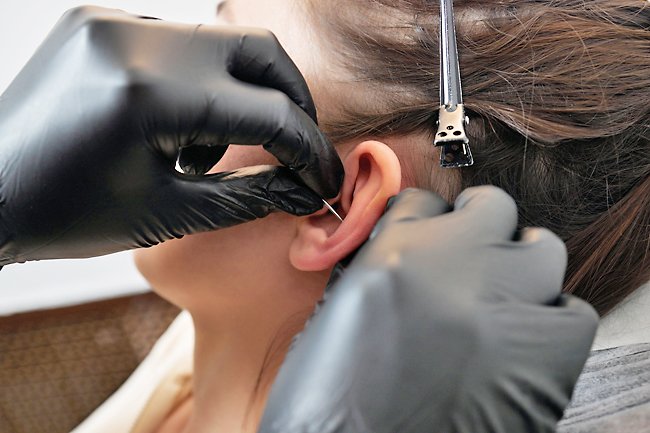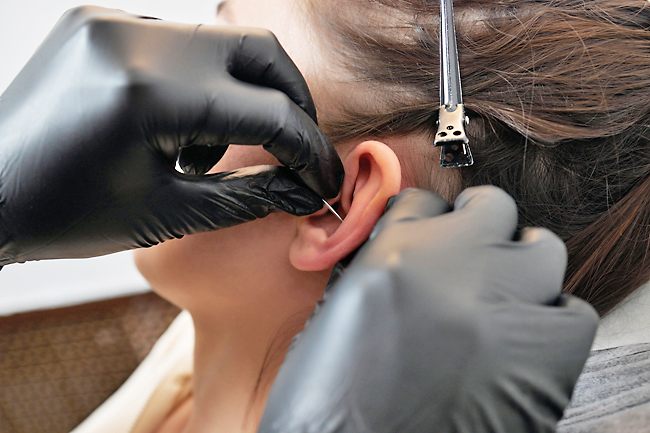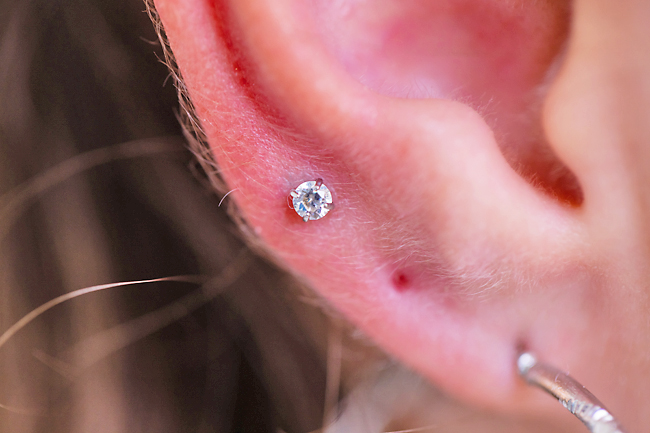
[ad_1]
Andrea Sachs
THE WASHINGTON POST – On a multiday bicycle trip through Indiana, I plowed into a bridge. But that accident was not nearly as alarming as the incident that occurred in the evening. I was relaxing in my hotel room when I noticed my silver earring on the carpet. I searched for the backing, only to discover that it was still attached to the stud.
In the bathroom mirror, I peered at a cavity in my earlobe as vast as the Buckskin Gulch in Utah. To my horror, I realised that the entire earring had slipped through the enlarged hole like a tiny slot canyon climber.
When you’re young and seemingly indestructible, the responsible adults in your life remind you to slather on sunscreen, eat your vegetables and wear a bike helmet. But no one warns kids with fresh piercings to protect their ears lest they wind up with stretched holes, elongated lobes or, in extreme cases, a lifetime sentence of unadorned ears.
“The delicate earlobe can only handle so much weight,” said a dermatologist and founder of Skin & Aesthetic Surgery of Manhattan Michelle Henry.
A confluence of factors can alter the pinprick shape and size of the pierced ear. As we age, our skin loses collagen and elasticity, as well as the fatty tissue that provides fullness to the teardrop body part. Gravity also works its dark magic.
The plump lobes of our youth can become as thin and deflated as overworked pie crust. A sensitivity or allergy to a metal such as nickel can lead to an infection or inflammation that weakens the holes’ interior skin. And, finally, heavy earrings worn often and irresponsibly can drag lobes southward. Eventually, they will retire down there.


“Once you start down this road,” said a plastic surgeon at the Quatela Center for Plastic Surgery in Rochester, New York Ashley Amalfi, “the only options are fillers or surgery”.
Some earring-wearers will set foot on that path sooner than others. Amalfi said people could start experiencing problems if the professional – or amateur – piercer missed the bull’s eye.
“From the get-go, if the piercing was done incorrectly, if it is asymmetrical, not centred or too close to the bottom,” she said, “there won’t be enough support for the earrings.”
My piercings were smack in the middle of my lobes, thanks to my pediatric surgeon father, who measured and marked the spots with a ruler and pencil. But placement isn’t everything; you need to pamper your ears as well.
You can slow down the ageing process with sunscreen and lotion. If you favour heavy pieces, such as chandelier earrings or chunky hoops, wear them sparingly and remove them as soon as possible. Also take off your earrings when showering or getting dressed, to avoid an entanglement with a tress or turtleneck. And never nod off in earrings, even small sparklers.
“The stud squashes the natural tissue,” Amalfi said, “especially if you are a side sleeper”.
If your condition is mild, you can try a product that purportedly provides extra support – a push-up bra for lobes. I sampled several designs. First, I experimented with a self-adhesive pad that attaches to the back of the ear like a motion sickness patch. I pushed the earring post through my ear and the transparent sticker, then secured the backing.
The company, Lobe Wonder, claims its invention “bears a major part of the earring weight, relieving the ear lobe of the pressure.” But I didn’t feel any relief, even in my healthier ear.
I had better results with “earring lifters”, sturdy backings that stabilise the earring. My glittery red danglers sat higher up on my ears, and I didn’t feel the usual drag.
In my online quest for treatments, I also discovered several DIY remedies of a suspicious nature, such as caulking the hole with toothpaste or crushed aspirin and sealing the opening with tape. The medical experts I spoke with rebutted these ideas.
“There is no home remedy that helps this problem,” Amalfi told me. “A topical will not regrow the tissue.”
And Chris Adigun, a board-certified dermatologist and medical director of the Dermatology & Laser Center in Chapel Hill, NC, said medicine-cabinet recipes can compound the trauma.
So, how do you know if your ears require medical intervention? There are several signs: If the earring points down instead of straight. If your lobes are different lengths. If the earring with the backing slips through the hole. And of course, in the most extreme scenario, when the jewellery rips through the bottom of the lobe, creating two flaps of skin.
If the hole is only slightly stretched out, a dermatologist, plastic surgeon or other cosmetics professional can inject hyaluronic acid, a temporary dermal filler, into the lobes. Henry compares the procedure to tightening a drawstring purse.
“The filler gathers the skin and functionally makes the hole smaller,” she said. The price tag varies by geography and the number of syringes used. At her practice, Henry said the procedure costs USD900 per ear. Adigun said the treatment goes for several hundred dollars.
Fillers fade after a year to 18 months, so you will need to re-plump in perpetuity. (Earlobe fillers received an endorsement from reality TV in 2018, when Brielle Biermann, the daughter of Real Housewives Kim Zolciak-Biermann, tweeted, “My mom gets filler in her ears because her diamond earrings are too heavy.”)
Some ears, such as my right one, are too far gone for filler. Surgery is the only solution.
Several specialists surgically repair piercings, including plastic surgeons, dermatologists and otolaryngologists with this skill set. Choose a physician who is board-certified in dermatology or plastic surgery or fellowship-trained in facial plastic surgery.
Health insurance companies consider the procedure to be cosmetic and will not cover it, with the possible exception of a tear that requires emergency surgery. As with filler, the price is based on location and the medical practitioner, but expect to pay at least USD500 per ear, including post-op piercing.
For the minor operation, the physician will remove the top layer of the skin inside the hole to create an injury similar to road rash. “You know how if you fall and scrape the top layer of skin on the pavement?” said plastic surgeon with Pioneer Valley Plastic Surgery in Massachusetts Melissa Johnson, who performed my surgery. “It’s like that.” The raw skin will spur the cells to regenerate and form scar tissue.
This is the reason the doctor can’t simply reduce the elongated portion with a stitch or two; the entire hole must be sealed shut. “It would be like sewing your fingers together,” Amalfi said. “Because they have skin on all sides, they could never heal together. But if both were cut open, they could heal together and be joined.”
During my consultation, Johnson took one glance at my sagging earlobe and knew she had to operate. My hole had stretched from one to five millimeters and was at risk of ripping.
Thankfully, my left ear was in better shape. I settled into a chair facing Cat in the Hat artwork by Dr Seuss. She injected a local anaesthesia to numb the ear, then carefully snipped away at the skin using a pair of small scissors.
She sewed up the front and back of the hole and covered the stitches with adhesive strips that blended in with my skin tone. The procedure took less than 30 minutes.
Recovery involves a lot of waiting. For the adhesives to fall off. For the stitches to dissolve.
For the scar tissue to build up. For the lobe skin to return to at least 80 per cent of its original strength. For six months to pass, when you can wear earrings again – the starter studs of your youth.
[ad_2]
Source link